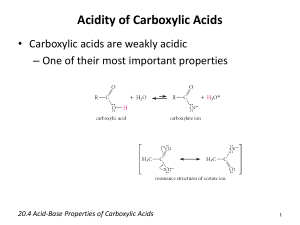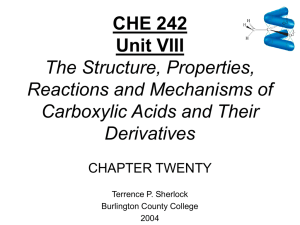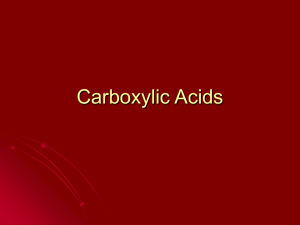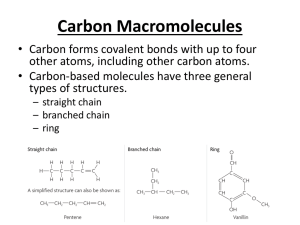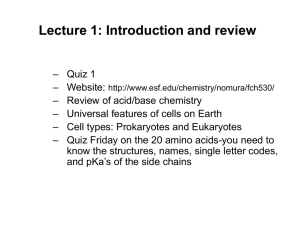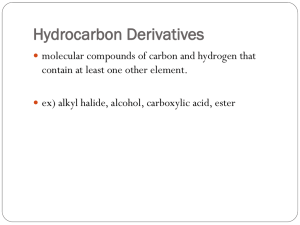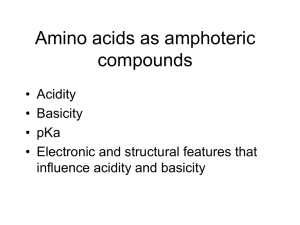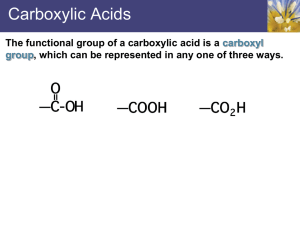Acidity of Carboxylic Acids.
advertisement
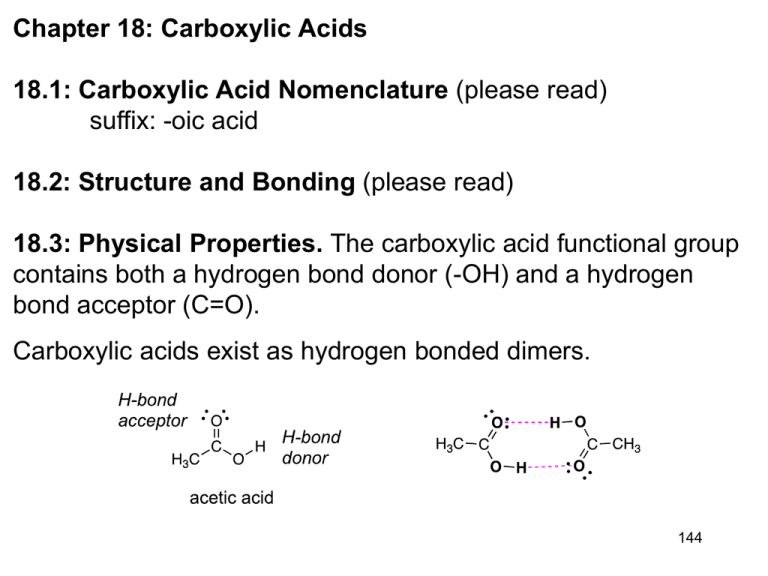
Chapter 18: Carboxylic Acids 18.1: Carboxylic Acid Nomenclature (please read) suffix: -oic acid 18.2: Structure and Bonding (please read) 18.3: Physical Properties. The carboxylic acid functional group contains both a hydrogen bond donor (-OH) and a hydrogen bond acceptor (C=O). Carboxylic acids exist as hydrogen bonded dimers. 144 18.4: Acidity of Carboxylic Acids. The pKa of carboxylic acids typically ~ 5. They are significantly more acidic than water or alcohols. Bronsted Acidity (Ch. 1.14): Carboxylic acids transfer a proton to water to give H3O+ and carboxylate anions, RCO2 Ka= [RCO2-] [H3O+] [RCO2H] typically ~ 10-5 for carboxylic acid pKa CH3CH3 ~50-60 pKa= - log Ka typically ~ 5 for carboxylic acid CH3CH2OH 16 PhOH 10 Increasing acidity CH3CO2H 4.7 HCl -7 145 The greater acidity of carboxylic acids is attributed to greater stabilization of carboxylate ion by: a. Inductive effect of the C=O group b. Resonance stabilization of the carboxylate ion C Od Od 4 -electrons delocalized over three p-prbitals C-O bond length of a carboxylates are the same 146 Bronsted Acid: proton donor (H+) weak acids (and bases) do not fully dissociate H-A + H2O H3O+ + A− [H3O+] [A−] __________ Ka = acid dissociation constant [H-A] pKa = -log Ka pH = -log [H3O+] Henderson-Hasselbalch Equation: Relates pKa with pH −] [A pH = pKa + log ______ [H-A] when [A−] = [H-A], the pH = pKa [A−] ______ pH − pKa = log [H-A] [A−] ______ = 10(pH−pKa) [H-A] 147 18.5: Substituents and Acid Strength. The pKa of a carboxylic acid can be influenced by substituents on the -carbon, largely through inductive effects. Electron-withdrawing groups increase the acidity (lower pKa) and electron-donating groups decrease the acidity (higher pKa). (see table 18.2, p. 784) pKa pKa 4.7 4.9 2.9 5.1 1.3 0.9 4.8 4.9 4.7 Inductive effects work through -bonds, and the effect falls off dramatically with distance 148 pKa 4.9 4.5 4.1 2.8 18.6: Ionization of Substituted Benzoic Acids. The charge of the carboxylate ion cannot be delocalize into the aromatic ring. Electron-donating groups decrease the acidity. Electronwithdrawing groups increase the acidity. (Table 18.3, p. 786) pKa R= -CH3 -F -Cl -Br -OCH3 -NO2 4.7 pKa 3.9 3.3 2.9 2.8 4.1 2.2 4.3 4.2 4.3 3.9 3.8 3.8 4.1 3.5 4.4 4.1 4.0 4.0 4.5 3.4 149 18.7: Salts of Carboxylic Acids. Carboxylic acids react with base to give carboxylate salts. pKa 5 (stronger acid) 15.7 (stronger base) (weaker base) (weaker acid) Detergents and Micelles: substances with polar (hydrophilic) head groups and hydrophobic tail groups form aggregates in water with the carboxylate groups on the outside and nonpolar tails on the inside. Steric acid 150 18.8: Dicarboxylic Acids. one carboxyl group acts as an electron-withdrawing group toward the other and lowers its pKa; the effect decreases with increasing separation Oxalic acid (n= 0) pKa1= Malonic acid (n= 1) Succinic acid (n=2) Glutaric acid (n=3) Adipic acid (n=4) Pimelic acid (n=5) 1.2 2.8 4.2 4.3 4.4 4.7 pKa2= 4.2 5.7 5.6 5.7 5.4 5.6 18.9: Carbonic Acid (please read) 151 18.10: Sources of Carboxylic Acids. Summary of reaction from previous chapters that yield carboxylic acids (Table 18.4, p. 791) a. Side-chain oxidation of alkylbenzene to give benzoic acid derivatives (Ch. 11.12): reagent: H2CrO4/H2Cr2O7 -or- KMnO4 b. Oxidation of primary alcohols (Ch. 15.9) reagent: H2CrO4/H2Cr2O7 c. Oxidation of aldehydes (Ch. 17.15) reagent: H2CrO4/H2Cr2O7 152 18.11: Synthesis of Carboxylic Acids by the Carboxylation of Grignard Reagents. Grignard reagents react with CO2 to afford carboxylic acids. An additional carbon (the CO2H group, which is derived from CO2) is added to the Grignard reagent. Grignard reagents are strong bases and strong nucleophiles. As such, they are incompatible with acidic (alcohols, thiols, amines, carboxylic acid, amides,) or electrophilic (aldehydes, ketones, 153 esters, nitrile, halides) groups. 18.12: Synthesis of Carboxylic Acids by the Preparation and Hydrolysis of Nitriles. Cyanide ion is an excellent nucleophile and will react with 1° and 2° alkyl halides and tosylates to give nitriles. This reaction add one carbon. The nitrile can be hydrolyzed to a carboxylic acid Cyanohydrins (Ch. 17.7) are hydrolyzed to -hydroxy-carboxylic acids. 154 18.13: Reactions of Carboxylic Acids: A Review and Preview. (Table 18.5, p. 795) a. Conversion to acid chlorides (Ch. 12.7). Reagent: SOCl2 b. Reduction to a 1° alcohol (Ch. 15.3). Reagent: LiAlH4 Carboxylic acids are reduced to 1° alcohols by LAH, but not by NaBH4. R-CO2H a. LiAlH4, THF b. H3O+ RCH2OH c. Acid-catalyzed esterification (Ch. 15.8) Reagent: R’OH, H+ (-H2O) 155 18.14: Mechanism of Acid-Catalyzed Esterification. Fischer Esterification (p. 796-797) 156 18.15: Intramolecular Ester Formation: Lactones. Lactones are cyclic esters derived from the intramolecular esterification of hydroxy-carboxylic acids. 4-Hydroxy and 5-hydroxy acids cyclize readily to form 5- and 6-membered ring ( and ) lactones. -valerolactone 157 18.16: Decarboxylation of Malonic Acid and Related Compounds. Carboxylic acids with a carbonyl or nitrile group at the -position will decarboxylate (lose CO2) upon heating Decarboxylation initially leads to an enol of the -carbonyl group. This is a key step in the acetoacetic ester synthesis (Ch. 20.10) 158 and malonic acid synthesis (Ch. 20.11). 18.17: Spectroscopic Analysis of Carboxylic Acids Infrared Spectroscopy Carboxylic acids: Very broad O-H absorption between 2500 - 3300 cm1 broader than that of an alcohol Strong C=O absorption bond between 1700 - 1730 cm1 O-H C=O No C=O O-H C-H C-H 159 NMR: The -CO2H proton is a broad singlet near ~12. When D2O is added to the sample the -CO2H proton is replaced by D causing the resonance to disappear (same for alcohols). The -CO2H proton is often not observed. 1H 13C NMR: The chemical shift of the carbonyl carbon in the 13C spectrum is in the range of ~165-185. This range is distinct from the aldehyde and ketone range (~190 - 220) -CO2H (180 ppm) 160 problem 18.33b O-H C=O 128.7 123.9 146.8 45.3 179.7 18.0 147.4 161
